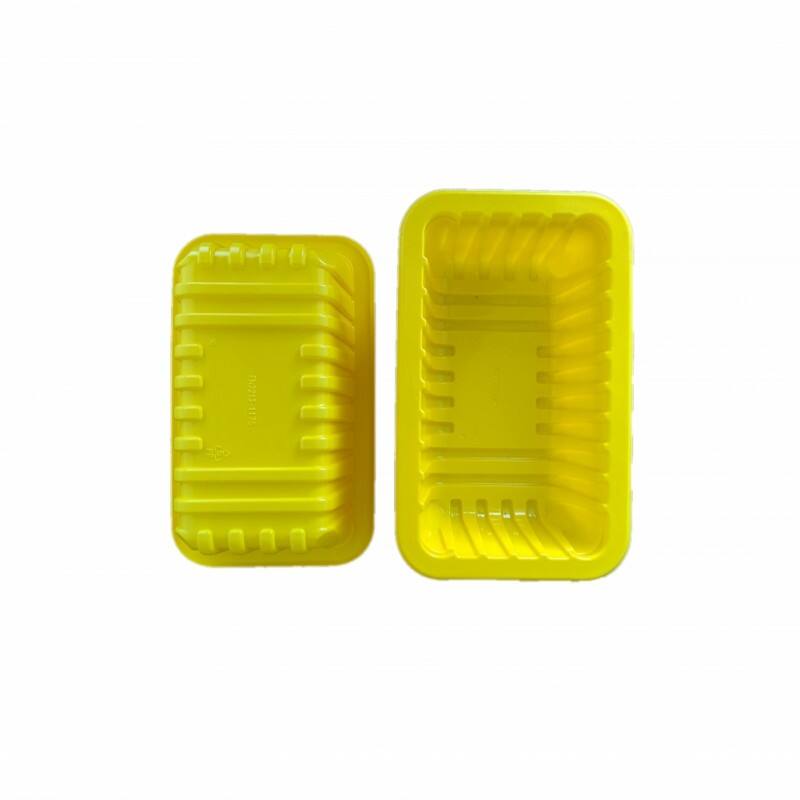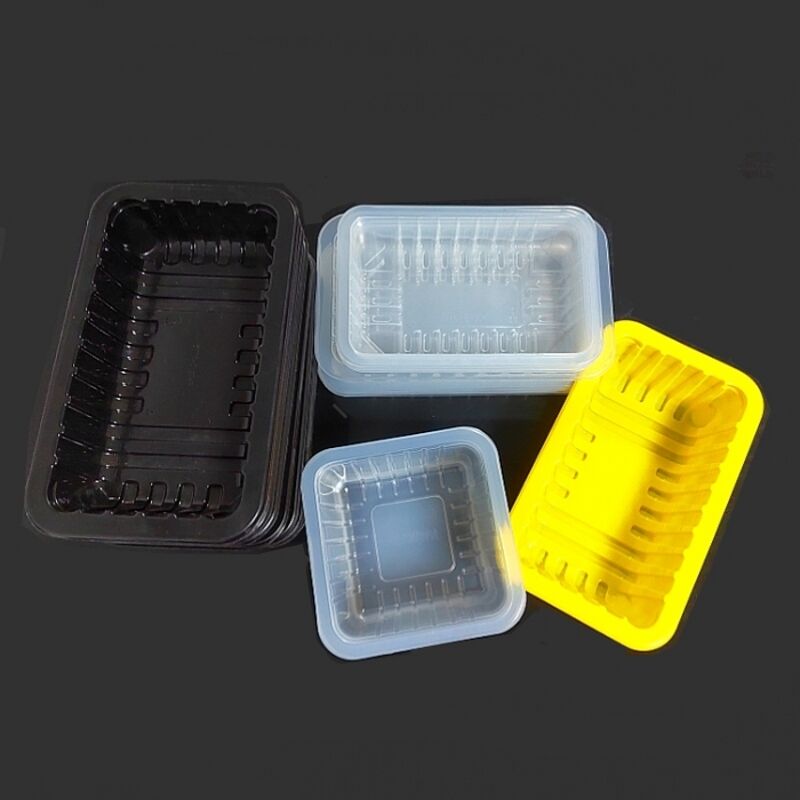Understanding Roll Over Wrap Trays: Modern Packaging Innovation
Core Technology Behind Roll Over Wrap Trays
The Roll Over Wrap Tray represents something pretty special in today's packaging world thanks to its use of advanced thermoforming methods. These techniques let manufacturers shape plastic with incredible accuracy, which means better protection for whatever gets wrapped inside while still looking good on store shelves. What's really neat about this approach is that items stay safe during transport without taking up extra room, making them stack much more efficiently than traditional packaging solutions. Some companies report saving warehouse space and reducing shipping costs because of these improvements.
The sealing mechanism is another critical facet of the Roll Over Wrap Tray's design. Typically, these trays utilize cutting-edge methods such as heat sealing and adhesive bonding. These methods ensure the tray maintains its structural integrity during transportation and handling, providing a robust solution for various industries.
The way Roll Over Wrap Trays get made has changed quite a bit thanks to all the robots and automated systems coming into play lately. Factories can now run their production lines much smoother than before, which means they churn out products faster while still keeping things looking good on the assembly line. What's really nice about this improved efficiency is that it cuts down costs for manufacturers and helps them keep up with customer orders even when demand spikes unexpectedly during busy seasons or special promotions.
Material Composition and Sustainability Features
The Roll Over Wrap Tray is pretty much a green product because of how it's made. Most of them use recyclable plastic stuff like PET or even better, recycled PET (RPET). This shows companies are starting to think more about where their materials come from and what happens after use. What's great about these plastics is that they can actually go back into the recycling system instead of ending up in landfills. Plus, compared to regular packaging materials, these trays leave behind way less carbon pollution during production. For businesses looking to cut down on waste while still getting good quality packaging, this seems like a smart move forward.
The life cycle assessment of PET and RPET underscores their recyclability, which is a pivotal contributor to minimizing environmental impact. By opting for materials that can be reprocessed post-consumption, businesses are aligning with the ecological preferences of consumers and regulatory mandates.
Innovations in biodegradable alternatives are on the horizon, setting the stage for even more sustainable packaging solutions. As research advances, the industry might see a broader adoption of such materials, offering consumers and businesses greener choices without compromising on the performance of packaging technology like Roll Over Wrap Trays.
Traditional Packaging Methods: Foam Trays and Alternatives
Common Materials in Conventional Tray Packaging
Most packaging trays we see on store shelves today are still made from foam polystyrene or PVC. These materials work well because they last a long time and don't cost much to produce, but they come with serious environmental downsides. Foam polystyrene especially stands out for being light weight and good at keeping things insulated, which is why so many companies use it. The problem? It doesn't break down naturally at all, creating massive amounts of trash that ends up in landfills or worse, floating around in our oceans. Recently though, there's been movement toward greener options like paperboard and various biodegradable materials. Some companies now make trays from cornstarch or sugarcane derivatives that actually decompose over time without harming the environment. Still, plenty of manufacturers struggle with choosing between cheaper traditional materials and pricier eco-friendly alternatives. Many small businesses find themselves stuck between wanting to do the right thing for the planet and needing to keep their bottom line healthy enough to stay in business.
Limitations in Seal Quality and Protection
Most foam trays suffer from weak seals that let air and bacteria in, making products more likely to get contaminated or go bad before they reach consumers. Traditional sealing techniques just don't hold up well enough, and this leads to higher numbers of returned items and spoiled stock sitting on shelves. Food manufacturers report losing money every month because of these problems, plus customers start to question brand reliability when packages fail repeatedly. Switching to newer packaging solutions such as Roll Over Wrap Trays makes a real difference though. Companies that made the switch noticed better protection against dust, moisture, and other outside factors that ruin food quality. One dairy processor saw their spoilage rate drop by almost half after implementing this technology last year. These kinds of improvements show why investing in updated packaging isn't just about keeping things looking good on store shelves it actually addresses fundamental shortcomings in how we package perishable goods today.
Key Performance Comparison: Roll Over vs. Traditional Systems
Seal Integrity and Leak Prevention Capabilities
Roll Over Wrap Trays offer better leak protection than most traditional packaging options on the market today. What makes them stand out? Well, they employ some pretty smart sealing tech that cuts down on leaks substantially. Food manufacturers who've switched to these trays report far fewer issues with leaking products. Some industry reports actually show around 30% fewer leaks happening with this system versus older methods. That kind of performance makes a real difference for businesses concerned about product quality. Not only does it keep goods safer during transport and storage, but it also means less waste overall since there's simply not as much spoilage from broken seals anymore.
Shelf Appeal and Product Visibility Differences
The Roll Over Wrap Tray design really grabs attention on store shelves, making products stand out among competitors. Made from clear plastic, these trays let shoppers see what's inside without opening anything first something that actually influences buying choices quite a bit. According to a recent survey by Packaging Insights magazine, around 68% of consumers say they pick up items they can look through before purchase. Many grocery chains across the country have seen their sales jump after adopting these transparent displays, particularly for snack foods and household goods where visual inspection matters most. The bottom line? Products need to catch the eye at first glance if they want to make it into shopping carts and ultimately boost brand presence in crowded retail environments.
Plastic Usage Reduction Metrics
Roll Over Wrap Trays cut down on plastic waste when compared to those old school foam trays we've all seen before, which helps move us toward greener practices. What makes these trays special is their clever design approach that actually uses way less plastic for each item wrapped up inside. Some research indicates they might slash plastic consumption by around half, though exact numbers can vary depending on what's being packaged. With so many shoppers now asking for less plastic in their deliveries, these wrap trays are becoming pretty popular alternatives without sacrificing how well things stay protected during transport. We're definitely seeing a shift in packaging preferences lately, and companies adopting this kind of eco smarter packaging tend to connect better with today's environmentally aware consumers.
Automation Compatibility in High-Speed Operations
Retrofitting Existing Packaging Lines with Roll Over Systems
Adding Roll Over Wrap Tray systems to current packaging operations makes good business sense for companies wanting to boost productivity. Most manufacturers report that installing these systems on existing production lines goes surprisingly smoothly, which gives them an advantage over competitors still using older methods. When it comes to actually making the switch, there are some technical considerations involved. The installation usually requires modifying equipment to handle the special tray positioning and different sealing process that Roll Over systems need. What this means in practice is smoother product movement through the line and fewer stoppages during operation. Packaging professionals often share case studies where plants saw real gains after implementing these changes. Some facilities reported output jumps of up to 30% while others noticed their packaging waste dropped significantly. These real world results show why so many forward thinking businesses are investing in Roll Over Wrap Tray technology despite the initial setup costs.
Traditional Packaging Throughput Limitations
Most traditional packaging setups run into serious throughput problems because their sealing and filling processes just can't keep up. Older machines simply aren't built for the kind of speed modern production lines demand these days. When companies look at actual performance numbers, Roll Over Wrap systems stand out明显地 (significantly) better than standard approaches, typically processing products at much faster rates. Businesses across various sectors have seen real results after switching to ROR technology. One food manufacturer reported cutting down on those frustrating slowdowns between shifts while another beverage company noticed smoother transitions during product changeovers. The bottom line is that implementing Roll Over Wrap Trays reduces idle time and streamlines operations throughout the facility. For any industry where getting products packaged quickly matters most, this upgrade makes total sense both operationally and financially.

Making the Right Packaging Choice for Your Business
Environmental Goals vs. Operational Costs Analysis
Looking at what it costs to switch from regular packaging to Roll Over Wrap Trays matters a lot for companies making this decision. Businesses should think about both the initial investment they'll have to make and how much money they might save over time because there's less waste and products stay fresh longer on store shelves. Going green with packaging cuts down on trash removal bills and makes the company look better in customers' eyes who care about the environment. Better shelf life means products sell for longer periods before going bad, which actually boosts profits when less gets thrown away. Most experienced managers weigh all these things together, checking out what industry experts say plus customer feedback, trying to find that sweet spot between wanting to protect the planet and keeping the bottom line healthy. The companies that succeed usually manage to hit their green goals while still making enough money to keep growing.
Product Type and Market Positioning Factors
Figuring out which products work best with Roll Over Wrap Trays makes all the difference when it comes to getting the most out of them. Fresh produce, baked goods, and premium items tend to benefit most from this type of packaging. The trays provide better protection against damage while keeping products visible on store shelves. For instance, fresh seafood or delicate pastries look much more appetizing when displayed properly. Smart retailers are starting to see how incorporating innovative packaging solutions helps draw customers who care about both sustainability and style. When companies start thinking about packaging as part of their overall brand image rather than just a container, they stand out from competitors. The market clearly favors brands that get creative with eco-conscious materials without sacrificing visual appeal.
FAQ
What are Roll Over Wrap Trays used for?
Roll Over Wrap Trays are primarily used in packaging to protect and display products efficiently. They are especially useful in sectors like food, where maintaining freshness and visibility is crucial.
What materials are these trays made from?
These trays are typically crafted from recyclable plastics such as PET and RPET, known for their sustainability and recyclability.
How do Roll Over Wrap Trays contribute to sustainability?
By using recyclable and biodegradable materials, these trays significantly reduce the carbon footprint compared to traditional packaging methods. They also use less plastic, making them more eco-friendly.
Can existing packaging lines be upgraded to use Roll Over Wrap Trays?
Yes, existing packaging lines can be retrofitted to accommodate Roll Over Wrap Trays, improving efficiency and adapting current systems to modern requirements.
What are the benefits of using Roll Over Wrap Trays over traditional methods?
They offer superior seal integrity, reduce plastic usage by up to 50%, and enhance product visibility and shelf appeal, leading to better product protection and potential sales growth.

